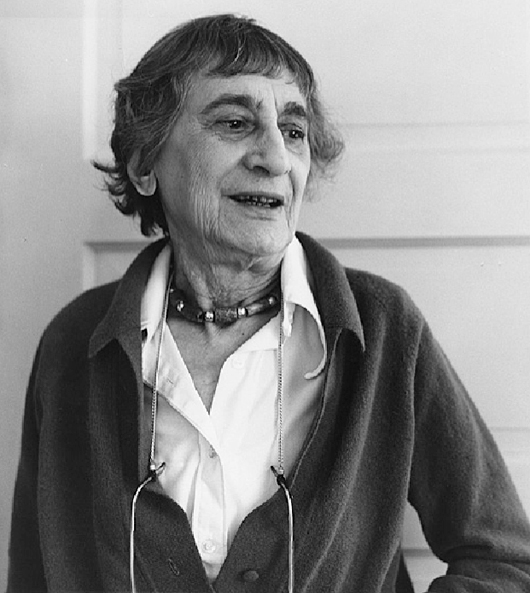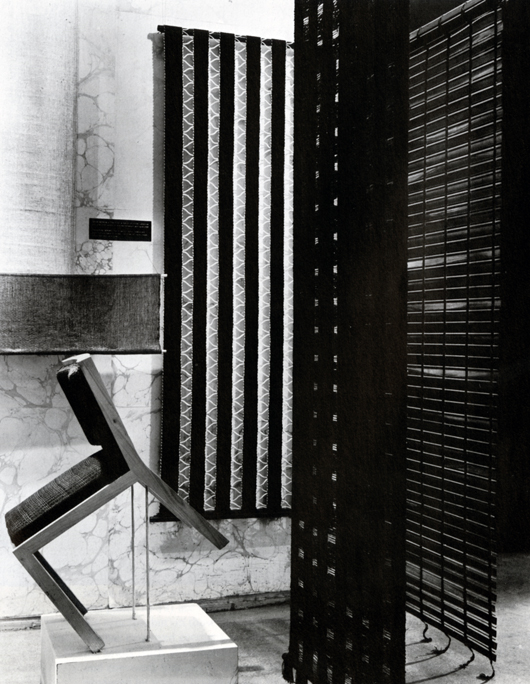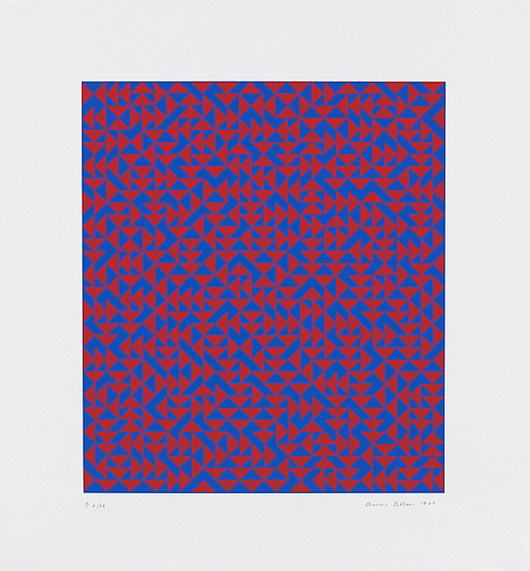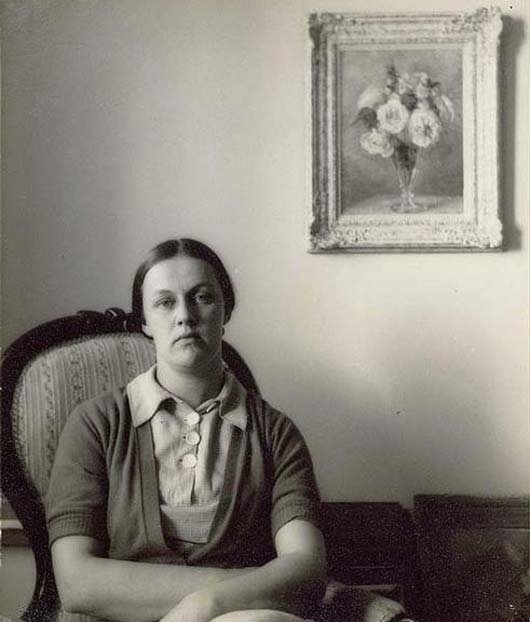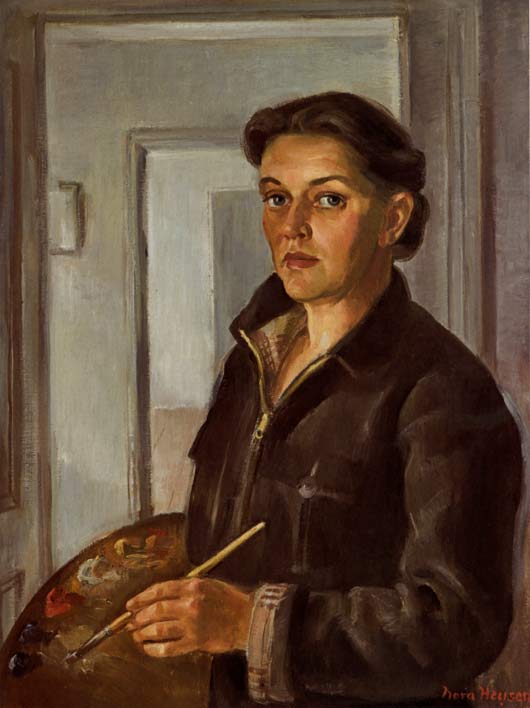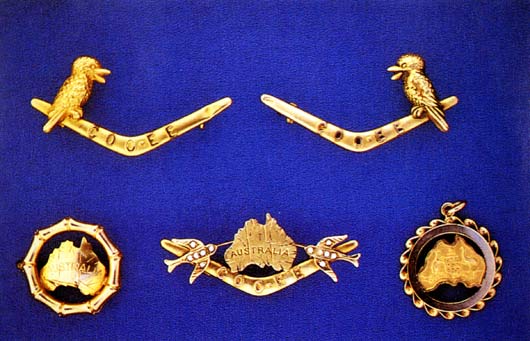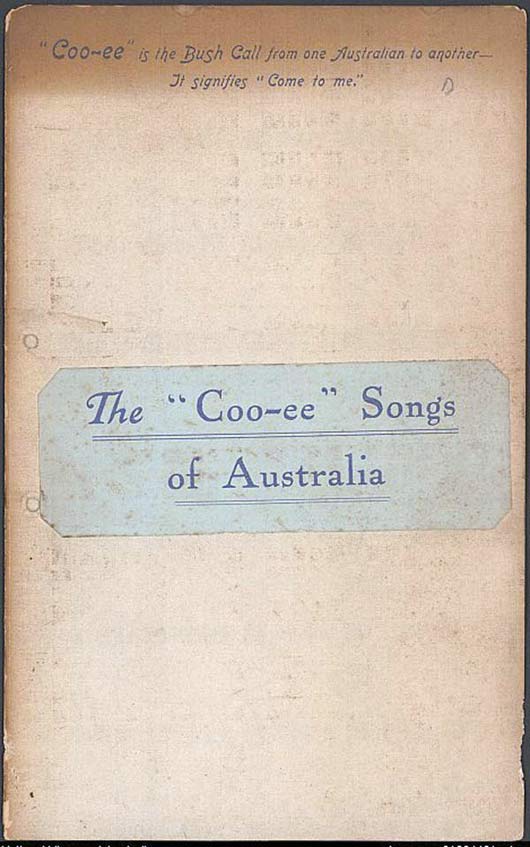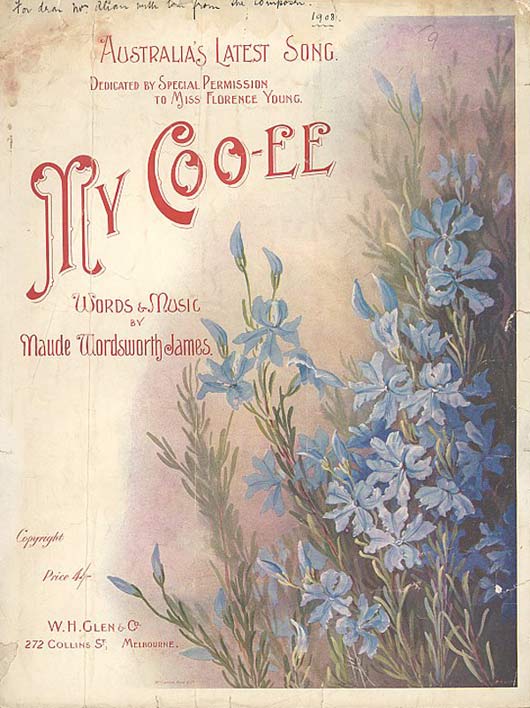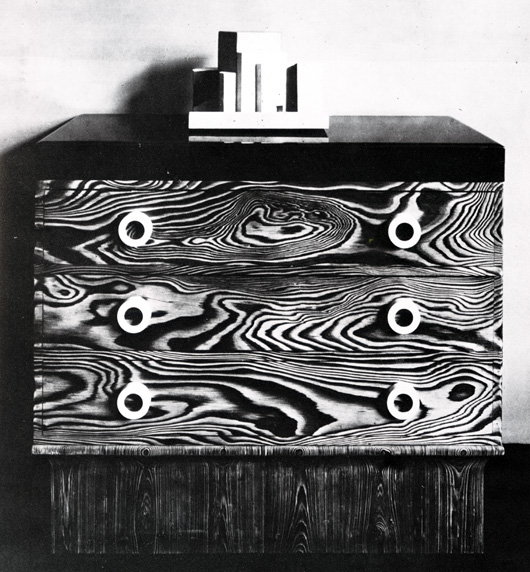Women from History: Grace Cossington Smith
By Julia Ritson Sydney born Grace Cossington Smith painted this work in 1915 and lucky for us Daniel Thomas convinced the Art Gallery of NSW to add it to their collection in 1960. It was from one of her first exhibitions. She was 23 years old.
The sock knitter, 1915
A painting of a good middle class daughter knitting socks for the men at war in 1915. That's it. But we are forced to look at the way the painting is made. It isn't really about Grace's sister Madge knitting socks. It's about painting and what the sitter feels.
The figure is pressed forward onto the picture plane. Tightly constructed. The creamy impasto paint of the backgrounds holds the picture together. The sitter then holds the background together. Like a jigsaw. She is the pattern maker. There are echoing triangles everywhere.
The walls are bare and overbearing. Probably how Madge was feeling. The dutiful daughter burden. She shows no emotion.
Smith loved patterns and colour. The artist said "my early paintings were much more of a pattern like... The sock knitter... In those days I felt everything was a pattern. It wasn't a forced thing at all."
Every thing a pattern. You can imagine her living in the one house for 60 years and continuing to find inspiration in all sorts of places. Her later work was almost all patterned.
Including this lovely mosaic-like patterned self portrait Grace painted in 1948.
Love Grace again.
Julia Ritson is a Melbourne artist. Her paintings investigate colour, abstraction and a long-standing fascination with the grid. Julia has enriched and extended her studio practice with a series of limited edition art scarves. She also produces an online journal dedicated to art and scarves and architecture.
Women from History: Non Objective Grace Crowley
By Julia Ritson Just before Australian artist Grace Crowley died in 1979, she bequeathed the few remaining paintings in her possession to Australian art museums and her papers to the Art Gallery of New South Wales.
I often wonder if artists hold on to particular paintings, the paintings they really like and don't want to let go of.
The National Gallery of Victoria scored this one and I think it is one of Grace's best.
The beauty of colour and form.
Crowley was one of Australia's first non objective painters. Although not recognised for this as she always promoted the work of her friend Ralph Balson ahead of her own.
Even the reference label for the painting at the museum refers to Ralph.
Crowley had said that it was harder being a woman artist and that women's art was much less acceptable than a man's. She admitted she had thought of using a man's name hoping they would sell better.
For years I've been trying to understand the structure of this painting.
Grace was a thinking woman and had studied with some of the best in Europe. She then went on to teach ideas like the golden section device to create perfect compositions. Exploring the mathematics of geometry and the language of light, colour, space and form.
What she achieves in this painting is to show the illusion of transparency while using opaque colours. Quite a hard thing to do. Involving a lot of pre planning.
See the darker pink slicing through the paler pink in this detail of the painting.
 Abstract Painting 1952, detail
Abstract Painting 1952, detail
For all her explorations, it's the colour and application of paint that pops.
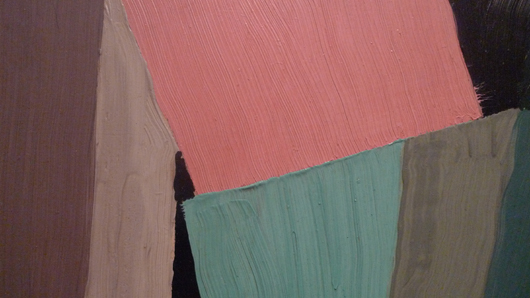 Abstract Painting 1952, detail
Abstract Painting 1952, detail
She was a superb colourist.
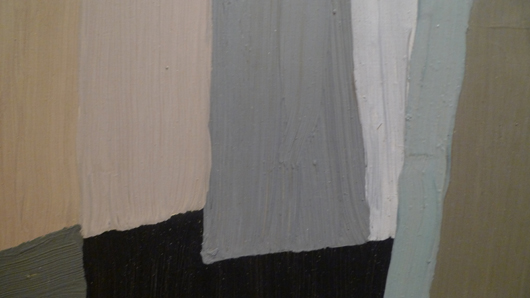 Abstract Painting 1952, detail
Abstract Painting 1952, detail
Colour and rhythm.
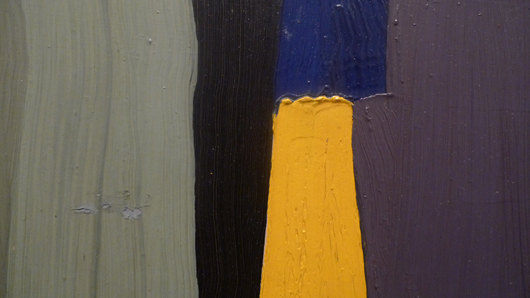 Abstract Painting 1952, detail
Abstract Painting 1952, detail
I love Grace.
Julia Ritson is a Melbourne artist. Her paintings investigate colour, abstraction and a long-standing fascination with the grid. Julia has enriched and extended her studio practice with a series of limited edition art scarves. She also produces an online journal dedicated to art and scarves and architecture.
Women from History: Cool Albers
By Julia Ritson "I find that a craft gives somebody who is trying to find their way a kind of discipline."
Artist Anni Albers was influenced by Paul Klee, and her wall hangings are like homages to the geometric watercolours of Klee. Klee called textiles "serving objects." Through Klee, Albers came to understand the functional side of textiles and gradually changed her palette from bold colours to more neutral and earth tones that were more likely to succeed commercially.
Anni Albers, photo by Betty Fiske, 1976
Bauhaus trained Albers turned from conventional weaver's materials to cellophane, jute and twisted paper to create unusual wall coverings and hangings including these elegant room dividers.
Installation view showing three free-hanging woven room dividers, from exhibition of Anni Albers' textiles at The Museum of Modern Art, New York, 1949
Anni Albers’ called her wall hangings pictorial weaving. Albers was the queen of the warp and the weft when she landed in the USA. Not only with her woven art but in her commissioned work with industrial textiles. Around 1949 Walter Gropius designed the Harvard Graduate Centre. He asked Albers to produce the bedspreads. They were practical, durable heavy linen and cotton. Albers says Gropius had requested something in an English ‘manly’ style’. He got it.
Bedspread for Harvard Graduate Centre, detail, 1950
After "endless years spent at the loom," Albers began producing prints in 1963. And in 1970, Albers collaborated with Kenneth Tyler at Gemini GEL. Tyler gifted part of his massive collection of prints to The National Gallery of Australia. Robert Hughes organised the whole thing. So we are very fortunate to have in Australia some beautiful works on paper by Anni Albers. There is so much scope with the grid. Albers took the classic device and created these etchings. She used the motif of a triangle within the grid like structure of a woven object. The line carries the meaning. Not the thread of a woven work. There is a cerebral distance in these works.
A coolness.
Second movement IV, 1978
Second movement V, 1978
Second movement II, 1978
Triangles, 1969
"Layer after layer of civilized life seem to have veiled our directness of seeing. We often look for an underlying meanings of things while the thing itself is the meaning."
Julia Ritson is a Melbourne artist. Her paintings investigate colour, abstraction and a long-standing fascination with the grid. Julia has enriched and extended her studio practice with a series of limited edition art scarves. She also produces an online journal dedicated to art and scarves and architecture.
Women from History: Girl Painter
By Julia Ritson "Girl Painter Who Won Art Prize is also Good Cook." That's the 1939 headline for a story about Nora Heysen in The Australian Women's Weekly. It just so happened she was the first female artist to win the Archibald prize - just as well she could cook.
Nora Heysen, portrait by Harold Cazneaux, 1939
Heysen was a portrait and still-life painter, but I think her portraits are more powerful. Here she is at 22. A year before leaving South Australia to spend three years in Europe.
Nora Heysen, A portrait study, 1933
She seems to be announcing her independence from her famous landscape painter father Hans Heysen. The work is precise, strong and earthy. An assessment of self. A self-assured girl painter. Many years later, Heysen settles in Sydney and paints this worldly self portrait.
Nora Heysen, Self-portrait, 1953
As with many of Heysen's self portraits, we see the artist holding her palette. When Dame Nellie Melba visited her father's studio the opera singer was so impressed by the 15 year old's work that she gave her the palette as encouragement.
The self portrait is like a reminder to an artist. I'm a painter, this is what I do. Here I am. 20 years on and I'm still full of confidence and ready to keep painting.
Hazel de Berg recorded interviews with about 250 painters and sculptors in the 1960s. Thanks to the amazing Hazel we can also hear the voice of Nora.
Julia Ritson is a Melbourne artist. Her paintings investigate colour, abstraction and a long-standing fascination with the grid. Julia has enriched and extended her studio practice with a series of limited edition art scarves. She also produces an online journal dedicated to art and scarves and architecture.
Women from History: Maude's Coo-ee!
By Julia Ritson Maude Wordsworth James was completely obsessed by the word ‘coo-ee.’
As an enthusiastic nationalist, Maude wanted to call Australia’s national capital 'Coo-ee' rather than Canberra.
She felt the word, which signifies ‘come to me,’ was our national call. In fact, the expression was an indigenous one, probably imitating the call of the Coo-ee bird.
One night in 1907, worrying about money in the gold rush city of Kalgoorlie, she was inspired; she would sell the coo-ee as a national souvenir - profitable patriotism.
Maude designed coo-ee jewellery, wrote coo-ee songs, made up coo-ee jokes, and her aim was for every home in Australia to have a coo-ee corner filled with her coo-ee curios, including a coo-ee cuckoo clock with a spear-carrying Aborigine emerging to coo-ee the hour.
Coo-ee crazy.
She made a pretty penny in her enterprise, but she went too far when she registered coo-ee as a trademark, patenting jewellery designs and copyrighting songs. She felt she owned coo-ee. So much so that when the Heidelberg district volunteers' farewell social committee made coo-ee medallions in 1916 she asked for royalties.
But oops, Maude had got it wrong - turns out you can't own a national symbol. Lawyers pointed out that she owned her coo-ee designs, not coo-ee itself and that as a national symbol, coo-ee belongs to all Australians.
Julia Ritson is a Melbourne artist. Her paintings investigate colour, abstraction and a long-standing fascination with the grid. Julia has enriched and extended her studio practice with a series of limited edition art scarves. She also produces an online journal dedicated to art and scarves and architecture.
Women from History: Tauber-Arp's Dance
By Julia Ritson Sophie Tauber-Arp's work was all about form and colour, rhythm and balance.
Trained as a textile designer, Tauber-Arp works the grid lovingly. The warp and the weft. The abundant stitches marching up, down, left, right create a beautifully rhythmical work. Tauber-Arp was also a dancer, so the rhythm came naturally.

Sophie Tauber-Arp, Vertical-Horizontal Composition, 1916
These little bags are stunning. She was also making necklaces and cushions to sell.
Sophie Tauber-Arp, Reticules, 1918
Sophie was one of those artists of the time who was very eager to merge art and everyday life. Abandoning the old concept of applied and fine arts as separate entities.
In 1927, Sophie said, 'The intrinsic decorative urge should not be eradicated, it is one of humankind's deep-rooted, primordial urges. The desire to enhance and beautify things cannot be construed as materialistic in the sense of increasing the value of one's property, rather it emanates from the urge for perfection and creative accomplishment.'
It's particularly lovely to see this composition. A clean architectural structure achieved by bringing together separate forms.
Sophie Tauber-Arp, View of Cadaqués, 1932
This striking gouache is a picture of space.
The lines cut through planes and delineate light from dark. Delicately coloured geometric forms move freely around the pictorial space.
Joy.
Sophie Tauber-Arp, Twelve Planar Spaces and Angular Bands, 1938
Sophie Tauber-Arp was an intriguing artist who let life flow seamlessly into art.
Julia Ritson is a Melbourne artist. Her paintings investigate colour, abstraction and a long-standing fascination with the grid. Julia has enriched and extended her studio practice with a series of limited edition art scarves. She also produces an online journal dedicated to art and scarves and architecture.
Women from History: Original Gray
By Julia Ritson Eileen Gray (1879-1976) was born in Ireland but lived in Paris. A thoroughly modern lady designing furniture while surrounded by the world of French couture.
After studying art at the Slade School in London, she moved away from painting saying she 'wanted to do something useful.'
Gray made friends with Japanese lacquer expert Seizo Sugawara and became deeply involved in the art of lacquering. It is a brutally hard craft with at least 22 steps required. Gray filled numerous notebooks with recipes for achieving different colours and surface textures in lacquer.
For this striking chest-of-drawers, Eileen Gray's recipe book gives directions for distressing wood to give it the appearance of an ancient sarcophagus. So I suppose it makes sense that the handles are made of bone!
Eileen Gray, chest-of-drawers made for Jean Désert, 1921
A grand couturier of the day, Jacques Doucet, purchased a table and Gray then began taking on commissions.
As a real lover of craft, Eileen also took an interest in rug making. She travelled to North Africa with Evelyn Wyld in 1909 to learn how to hand weave.
I love her rug work. Especially this gorgeous tribute to Kilkenny.
Eileen Gray, Kilkenny rug
Gray created pieces which were to inspire many designers. Joe Colombo's 1970 Boby Trolley was most definitely inspired by her wonderful pivoting storage cabinet.
Eileen Gray, Pivoting Drawers, c 1920s
This side table was one of Gray's favourite pieces and remained with her until her death at the age of 98. It's made of oak and sycamore. Full of lovely cantilevered planes that would characterise her architectural experiments in later years.
Eileen Gray, Small table in oak and sycamore, 1922
There are many contradictions in modernism. In the 1920s it was all about the machine age and taking out the human touch. But Gray was charmingly able to add a human element and still express modernist ideas.
A very useful talent.
Julia Ritson is a Melbourne artist. Her paintings investigate colour, abstraction and a long-standing fascination with the grid. Julia has enriched and extended her studio practice with a series of limited edition art scarves. She also produces an online journal dedicated to art and scarves and architecture.





